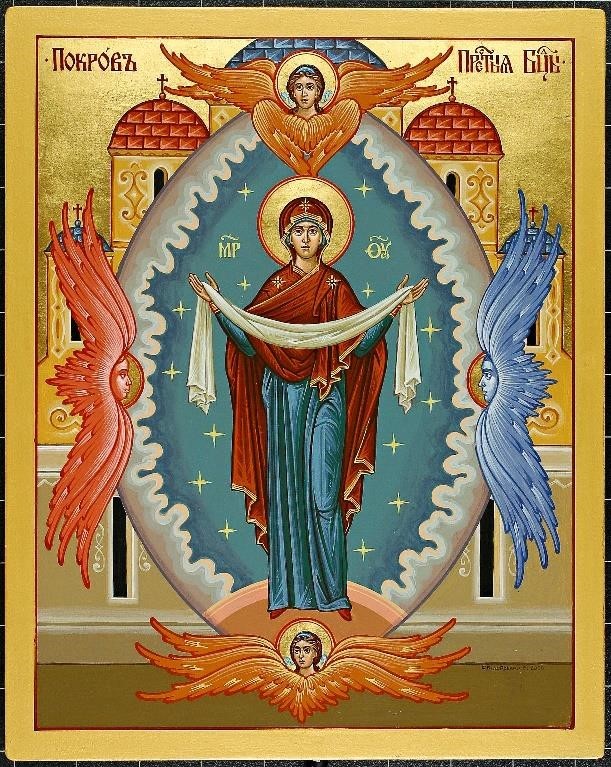by Brent Kostyniuk
Ukrainians have a deep devotion and love for the Mother of God. In fact, along with other Byzantine traditions, they have a unique title for her – Theotokos.
The term Theotokos is a compound of two Greek words: Θεός (Theo) meaning God, and τόκος (tokos) meaning childbirth or offspring. A literal translation would be “God-bearing one” although a customary English translation is “Mother of God.”
The use of the term Theotokos is very ancient. As early as the third century, Christians were turning to the Theotokos as evidenced in this Coptic prayer of that time: “Under your protection we seek refuge, holy Mother of God.”
It is known that Athanasius of Alexandria used the term in 330, Gregory the Theologian in 370, and John Chrysostom in 400. It has been suggested that Origen (d. 254) was the first to use the term Theotokos in reference to Mary. The use of Theotokos was formally affirmed at the Third Ecumenical Council held at Ephesus in 431. Theotokos has deep theological meaning for Eastern Christians; Mary truly became the Mother of God by the conception of the Son of God in her womb.
Christ Our Pascha, the catechism of the Ukrainian Greek Catholic Church explains it this way.
187 The Church of Christ, teaching about the Mystery of the Incarnation, focuses on the Person whom Mary conceived, and to whom she gave birth. … The title Theotokos means that it was the eternal Son of God who was born in the flesh from the Virgin Mary and became human. “From the God-bearing One, Jesus took flesh and became one in being with our human nature” [John of Damascus, Exact Exposition of the Orthodox Faith, III, 12]. In a special way the Church expresses this unity in being with the Icon of Tenderness, in the embrace of Mother and Son.
Along with her special title, Byzantine Christians also have their own version of the Hail Mary prayer. Although translations vary, the official English language version from the catechism, Christ Our Pascha, is:
Rejoice, Mother of God, Virgin Mary, full of grace, the Lord is with you. Blessed are you among women, and blessed is the fruit of your womb; for you have borne Christ, the Saviour and Redeemer of our souls.
The feast of the Protection of the Mother of God, one of the major feasts of the Slav Byzantine church calendar, is celebrated on October 1. It honours a miraculous intervention which took place in the ninth century. According to the ancient Chronicles of Nestor, the inhabitants of Constantinople prayed that the Mother of God would protect them from an attack by a large Rus’ (the early Slavic nation) army at a time when Rus’ was still pagan. The Theotokos appeared to St. Andrew the Fool for Christ inside Blachernae church in Constantinople (modern day Istanbul). Early in the morning of Sunday, October 1, Andrew saw the dome of the church open, and Mary enter, floating in the air above him, surrounded by angels and saints. Andrew saw Mary kneel and pray for all faithful Christians throughout the world. She also asked her Son, Jesus, to accept the prayers of all those who turned to Him for protection through her intercession. Afterwards, Mary rose and spread her veil over all the people in the church as a sign of her protection. Following the appearance of the Mother of God, the invading enemy was thwarted and the city spared disaster.
The name of the feast – Protection – is a translation of the Ukrainian word, Pokrov. However, Protection does not convey the full significance of Pokrov. It refers to a cloak or shroud, but it also means protection or intercession. For this reason, the name of the feast is also translated as the Veil of Our Lady, the Protecting Veil of the Theotokos, or the Intercession of the Theotokos. We are given the mental image of a caring and loving mother, spreading her cloak to shelter her children from harm. In the Protecting Veil icon, the palms of her hands are turned upwards towards heaven, with her pokrov spread between her outstretched arms.
The kontakion for the Feast of the Protection expresses our desire for that motherly intercession.
Today the Virgin stands before us in the church and together with the choirs of saints invisibly prays to God for us. Angels are worshipping with hierarchs, Apostles exult with prophets, for the Mother of God prays in our behalf to the eternal God.
Now, as Ukraine faces the horrors of a war brought on by foreign invasion, that kontakion brings special meaning and renewed hope that the Theotokos will once again spread her protective pokrov over our ancestral homeland and all its people.

